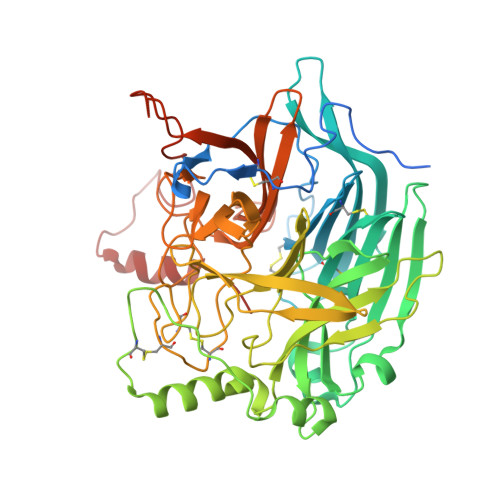Structure of the ulster strain newcastle disease virus hemagglutinin-neuraminidase reveals auto-inhibitory interactions associated with low virulence.
Yuan, P., Paterson, R.G., Leser, G.P., Lamb, R.A., Jardetzky, T.S.(2012) PLoS Pathog 8: e1002855-e1002855
- PubMed: 22912577
- DOI: https://doi.org/10.1371/journal.ppat.1002855
- Primary Citation of Related Structures:
4FZH - PubMed Abstract:
Paramyxovirus hemagglutinin-neuraminidase (HN) plays roles in viral entry and maturation, including binding to sialic acid receptors, activation of the F protein to drive membrane fusion, and enabling virion release during virus budding. HN can thereby directly influence virulence and in a subset of avirulent Newcastle disease virus (NDV) strains, such as NDV Ulster, HN must be proteolytically activated to remove a C-terminal extension not found in other NDV HN proteins. Ulster HN is 616 amino acids long and the 45 amino acid C-terminal extension present in its precursor (HN₀) form has to be cleaved to render HN biologically active. Here we show that Ulster HN contains an inter-subunit disulfide bond within the C-terminal extension at residue 596, which regulates HN activities and neuraminidase (NA) domain dimerization. We determined the crystal structure of the dimerized NA domain containing the C-terminal extension, which extends along the outside of the sialidase β-propeller domain and inserts C-terminal residues into the NA domain active site. The C-terminal extension also engages a secondary sialic acid binding site present in NDV HN proteins, which is located at the NA domain dimer interface, that most likely blocks its attachment function. These results clarify how the Ulster HN C-terminal residues lead to an auto-inhibited state of HN, the requirement for proteolytic activation of HN₀ and associated reduced virulence.
Organizational Affiliation:
Department of Structural Biology, Stanford University School of Medicine, Stanford, California, United States of America.
















